10 Types of Palm Plants to Grow Indoors
- January 24, 2024
- 0 comment
Indoor palm plants are renowned for bringing a touch of tropical elegance to any interior setting. Their lush foliage and distinctive forms make them a favorite choice for enhancing indoor environments. This guide focuses on 10 specific types of palm plants that are well-suited for indoor cultivation. Each variety presents unique characteristics, from the stately Areca Palm, known for its feathery fronds, to the compact Parlor Palm, ideal for smaller spaces. Understanding the individual needs and attributes of these palms is crucial for their successful growth indoors. This introduction aims to provide an overview of these varieties, offering insights into their care requirements and suitability for different indoor conditions.
List of 10 Different Types of Palm Plants to Grow Indoors
- Areca Palm
- Parlor Palm
- Kentia Palm
- Lady Palm
- Pygmy Date Palm
- Bamboo Palm
- Sago Palm
- Majesty Palm
- European Fan Palm
- Cat Palm
1. Areca Palm (Dypsis lutescens)

The Areca Palm is highly valued as an indoor plant for its air-purifying abilities, removing toxins like formaldehyde and benzene. Its lush, feathery fronds add a tropical aesthetic to any space, enhancing the room’s ambiance. Adaptable to various light conditions and easy to maintain, it’s suitable for both beginners and experienced plant enthusiasts. Additionally, its non-toxic nature makes it a safe option for households with pets and children. This palm can reach up to 6-7 feet indoors, making it a striking feature in larger rooms.
- Water Requirements: The Areca Palm prefers consistent moisture but is sensitive to overwatering. Water the plant when the top inch of soil feels dry. In winter, reduce watering to prevent root rot.
- Light Requirements: Bright, indirect light is ideal. It can adapt to medium light but may grow slower. Avoid direct sunlight, which can scorch the leaves.
- Color Varieties: The fronds of the Areca Palm are typically a vibrant green. New growth often has a slight yellow-green hue, which deepens to rich green as the fronds mature.
Additional Features:
- Growth Rate: Areca Palms have a moderate growth rate. With proper care, they can grow several feet over a few years.
- Temperature and Humidity: Prefers warm temperatures (65-75°F) and moderate to high humidity. Mist regularly or use a humidifier in dry environments.
- Soil Type: A well-draining potting mix is essential. A mix of peat, pine bark, and perlite works well.
- Fertilization: Feed with a balanced, water-soluble fertilizer during the growing season (spring and summer), reducing frequency in the fall and winter.
- Pruning: Prune yellow or brown fronds to keep the plant healthy and attractive. Trim close to the trunk, being careful not to damage it.
- Toxicity: Non-toxic to pets and humans, making it a safe choice for households with animals and children.
- Pest Resistance: Generally resistant to pests, but watch out for spider mites and scale insects, especially in dry indoor conditions.
2. Parlor Palm (Chamaedorea elegans)
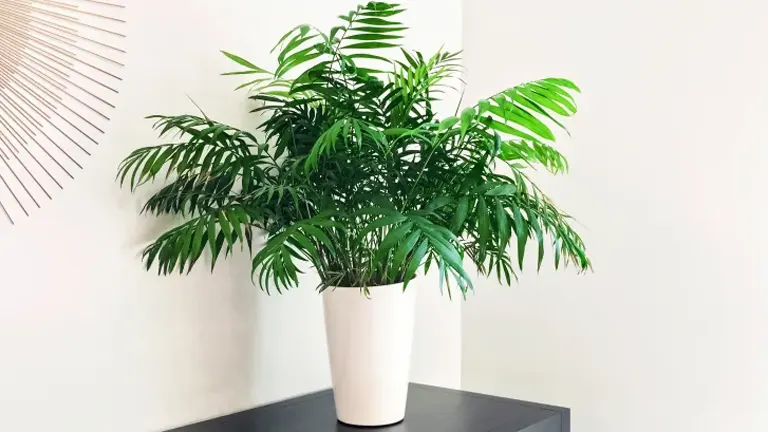
The Parlor Palm stands out as an indoor plant primarily for its elegant and non-intrusive growth habit. It’s well-suited for indoor conditions due to its tolerance for lower light levels and relatively dry air, typical in many homes. This palm has a slow growth rate, which means it won’t outgrow its space quickly, making it ideal for smaller living areas and offices. Its fine-textured fronds add a touch of sophistication without being overpowering. Plus, the Parlor Palm’s natural resistance to common houseplant pests minimizes maintenance efforts. Safe for pets and children, it’s a worry-free addition to any indoor setting.
- Water Requirements: Parlor Palms need to be watered when the topsoil becomes slightly dry. They do not tolerate overwatering well, as this can lead to root rot. During winter, reduce the frequency of watering.
- Light Requirements: Thrives in medium to low light conditions. Can adapt to fluorescent lighting, making it suitable for office environments. Direct sunlight should be avoided to prevent leaf burn.
- Color Varieties: The leaves of Parlor Palms are a deep green, which can bring a vibrant, refreshing look to indoor spaces. The foliage maintains its color even in lower light conditions.
Additional Features:
- Unique Growth Habit: The Parlor Palm has a clumping growth pattern, forming dense and lush foliage. This makes it particularly suitable for filling up space and creating a green focal point in indoor areas.
- Leaf Texture: Its leaves have a fine, almost feathery texture, contributing to a softer appearance compared to other palms. This texture can add a sense of delicacy to its surroundings.
- Adaptability to Pot Size: Remarkably adaptable to pot size, the Parlor Palm can be kept in a smaller pot to limit its growth or repotted into a larger one to encourage more growth. This adaptability makes it an excellent choice for varying indoor spaces and decor needs.
- Flowering Capability: In ideal conditions, the Parlor Palm can produce small, yellow flowers, which is a rare and delightful feature for indoor palms. Although flowering is uncommon in indoor settings, it can be a pleasant surprise when it occurs.
- Air Humidity Preference: While it can tolerate low humidity, the Parlor Palm thrives in higher humidity environments. This preference makes it a great choice for naturally humid rooms or for use with a humidifier to enhance leaf health and appearance.
- Container Versatility: Its elegant and compact form makes it suitable for a variety of container types, from classic terracotta to modern decorative pots. This versatility allows it to easily fit into different interior design themes.
3. Kentia Palm (Howea forsteriana)

The Kentia Palm is prized as an indoor plant for its elegant and upright growth, bringing a sophisticated and natural aesthetic to any room. Its resilience in low light conditions and ability to tolerate dry indoor air make it particularly suitable for indoor settings where other plants might struggle. It’s a slow-growing palm, eventually reaching up to 10 feet, making it a graceful addition to spacious rooms. Additionally, its long, arching fronds create a soft, relaxed atmosphere, contributing to a more tranquil and inviting space. This palm’s tolerance for a range of indoor temperatures also makes it a versatile choice for various home or office environments.
- Water Requirements: Prefers consistent moisture, but it’s important to let the soil dry out slightly between waterings. Overwatering can lead to root rot, so ensure good drainage. In winter, reduce the frequency of watering.
- Light Requirements: Does well in low to medium light conditions but can benefit from occasional exposure to bright, indirect light. Direct sunlight should be avoided as it can scorch the leaves.
- Color Varieties: The fronds are a deep, glossy green, adding a touch of elegance to indoor spaces. The color remains consistent in varying light conditions, a trait that adds to its decorative versatility.
Additional Features:
- Growth Habit: Exhibits an upright growth pattern with arching fronds that spread outwards. This growth habit makes it an excellent choice for corners or as a room divider.
- Leaf Texture: Features broad, slightly drooping leaflets that give it a lush, tropical appearance.
- Air Purifying: Like many palms, the Kentia Palm is effective at improving indoor air quality by filtering out common pollutants.
- Temperature Tolerance: Prefers a temperature range of 60-80°F. Avoid exposure to temperatures below 55°F as it is not cold-tolerant.
- Soil Preference: A peat-based potting mix with good drainage is ideal. It appreciates soil that is rich in organic matter.
- Fertilization: Feed with a palm-specific fertilizer or a general houseplant fertilizer at half strength during the growing season.
- Pruning Needs: Minimal pruning is required. Remove only the dead or damaged fronds to maintain its appearance.
- Pest Resistance: Generally resistant to pests, but can be susceptible to spider mites and scale insects in dry indoor conditions. Regular misting or wiping down the leaves can help prevent these issues.
4. Lady Palm (Rhapis excelsa)
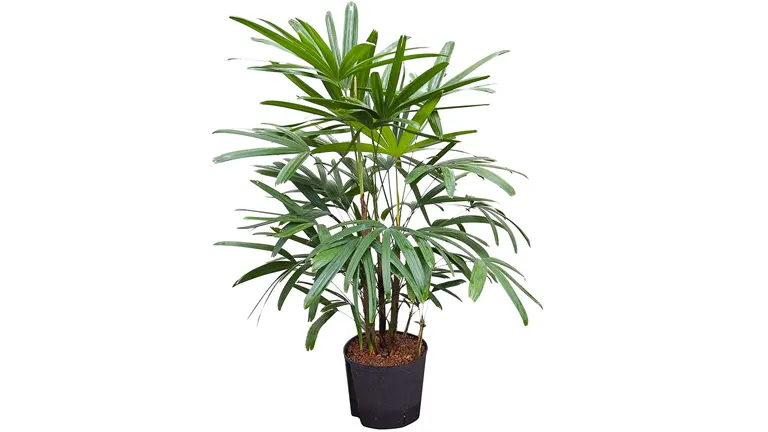
The Lady Palm is highly regarded as an indoor plant for its adaptability and aesthetic appeal. Unique for its broad, dark green leaves that create a lush, dense canopy, it adds a sophisticated touch to any interior. One of its standout features is its ability to thrive in a wide range of lighting conditions, from low light to bright, indirect sunlight, making it versatile for different indoor environments. Additionally, the Lady Palm is known for its air-purifying capabilities, effectively filtering indoor air pollutants. It’s also relatively easy to care for, requiring minimal pruning and being more resistant to pests compared to other houseplants. Its non-toxic nature makes it a safe choice for homes with pets and children, further enhancing its suitability as an indoor plant.
- Water Requirements: Prefers evenly moist soil but is tolerant of some dryness. It’s important to avoid overwatering and ensure the pot has good drainage. During winter, reduce watering but do not let the soil become completely dry.
- Light Requirements: Adaptable to a range of light conditions, from low light to filtered, indirect sunlight. Avoid prolonged exposure to direct, harsh sunlight as it can damage the leaves.
- Color Varieties: The Lady Palm’s leaves are a rich, dark green. With adequate care, the color remains vibrant, contributing to its aesthetic appeal.
Additional Features:
- Growth Rate: It grows at a moderate pace, making it suitable for long-term indoor cultivation without frequent repotting.
- Leaf Shape: Features broad, fan-shaped leaves, divided into segments, giving it a unique and attractive appearance.
- Air Purification: Effective in removing airborne toxins, which makes it a healthy addition to indoor spaces.
- Temperature Tolerance: Prefers average room temperatures (65-75°F) but can tolerate a wider range, from 55°F to 80°F.
- Soil Preference: Well-draining soil rich in organic matter suits this palm best. A mix of peat, pine bark, and perlite can be ideal.
- Fertilization: Light feeding during the growing season with a balanced, slow-release fertilizer is beneficial.
- Pruning Requirements: Minimal pruning is needed. Remove only the damaged or discolored fronds to keep the plant looking neat.
- Pest Resistance: While it’s generally resistant to pests, occasional issues with spider mites or scale can occur. Regular cleaning of leaves can help prevent infestations.
5. Pygmy Date Palm (Phoenix roebelenii)
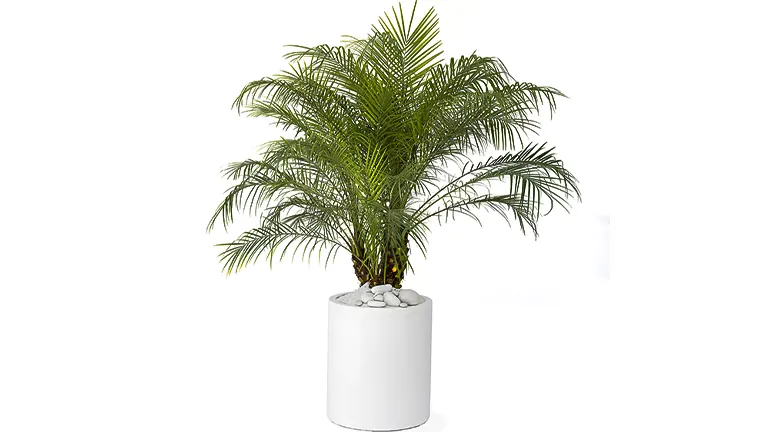
The Pygmy Date Palm is celebrated for its suitability as an indoor plant due to its manageable size and ornamental appearance. Ideal for small spaces, it reaches up to 6 feet, making it perfect for tabletops or as a floor plant without overwhelming the room. Its elegant, arching fronds add a sophisticated and tropical aesthetic to indoor environments. This palm thrives in bright, indirect light, aligning well with typical indoor lighting conditions. Additionally, it’s known for being more tolerant to irregular watering compared to other palms, offering a degree of forgiveness for busy or forgetful owners. Its ability to adapt to indoor temperatures and its non-invasive root system make it a practical and attractive option for home and office settings.
- Water Requirements: Prefers consistent moisture in the soil but is sensitive to overwatering. Ensure the top inch of soil dries out between waterings. In winter, water less frequently to match the plant’s reduced growth rate.
- Light Requirements: Thrives in bright, indirect light. Can tolerate some direct sunlight but excessive direct light can scorch the leaves. If the light is too low, its growth may slow down.
- Color Varieties: The fronds are typically a lush, deep green, adding a vibrant tropical feel to indoor spaces. The leaflets are fine and feathery, giving a delicate appearance to the plant.
Additional Features:
- Distinct Growth Pattern: The Pygmy Date Palm typically develops a slender, single trunk which, in older plants, can exhibit an interesting patterned effect due to the remnants of old leaf bases.
- Foliage Characteristics: The fronds of this palm have a unique, fine texture with a graceful arch, which adds an element of softness to the plant’s overall appearance.
- Potential for Outdoor Growth: While ideal for indoors, this palm is also capable of outdoor growth in warmer climates. It’s versatile enough to be transitioned to an outdoor setting during warmer months in temperate regions.
- Flower and Fruit Production: Under optimal conditions, it can produce small, creamy-white flowers, which are followed by tiny, edible dates. However, flowering and fruiting are rare in indoor settings.
- Root System: The Pygmy Date Palm has a non-invasive root system, making it a safe choice for planting near walkways or structures, and suitable for container growth without rapid pot-bound issues.
- Adaptability to Pruning: While minimal pruning is needed, this palm is quite adaptable to pruning and can be shaped according to aesthetic requirements or space constraints.
6. Bamboo Palm (Chamaedorea seifrizii)
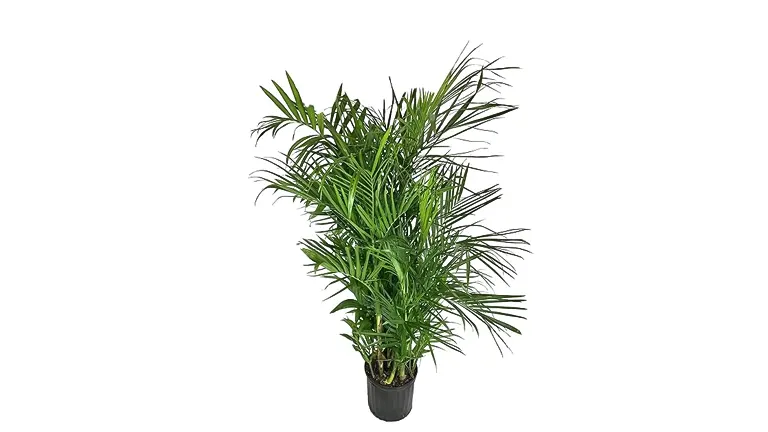
The Bamboo Palm, with its distinctive bamboo-like stems and lush, green foliage, is a favorite for indoor settings due to its adaptability and visual appeal. It excels in low-light conditions, making it ideal for rooms that don’t receive abundant natural sunlight. This palm is particularly noted for its air-purifying abilities, effectively removing toxins like formaldehyde and benzene, thereby contributing to a healthier indoor environment. Its moderate growth rate and resistance to common houseplant pests make it a low-maintenance choice, suitable for both beginners and experienced plant enthusiasts. Additionally, its non-toxic nature makes it a safe option for homes with pets. The Bamboo Palm’s ability to thrive in typical indoor humidity levels adds to its versatility, making it a practical and attractive addition to homes and offices alike.
- Water Requirements: Prefers consistent moisture, but the soil should not be waterlogged. Water when the top inch of the soil feels dry. Overwatering can lead to root rot, so proper drainage is essential.
- Light Requirements: Thrives in moderate to low light. Can adapt to bright, indirect light but should be protected from direct sunlight, which can scorch the leaves.
- Color Varieties: The fronds are typically a rich green, which can vary slightly in shade depending on light exposure. In ideal lighting, the foliage maintains its vibrancy, adding a lush look to indoor spaces.
Additional Features:
- Tolerance to Varied Humidity Levels: Bamboo Palms are adaptable to a range of humidity levels, making them suitable for different indoor environments, from dry to humid.
- Growth Rate and Size: This palm grows at a moderate rate and can reach up to 6-7 feet indoors, making it a substantial addition to interior spaces without overwhelming them.
- Soil Preferences: Prefers a well-draining soil mix. A combination of peat, sand, and loam ensures proper drainage and nutrient retention.
- Container Growing: Ideal for container growing, it adapts well to pot-bound conditions, requiring repotting only every couple of years.
- Foliage Density: Its dense foliage creates a lush, mini-jungle effect, perfect for adding greenery and a tropical feel to any room.
- Decorative Versatility: With its unique bamboo-like appearance, this palm fits well in both minimalist and more elaborately decorated spaces, complementing various interior styles.
- Ease of Propagation: Can be propagated relatively easily through division, allowing gardeners to multiply their collection or share with friends.
7. Sago Palm (Cycas revoluta)
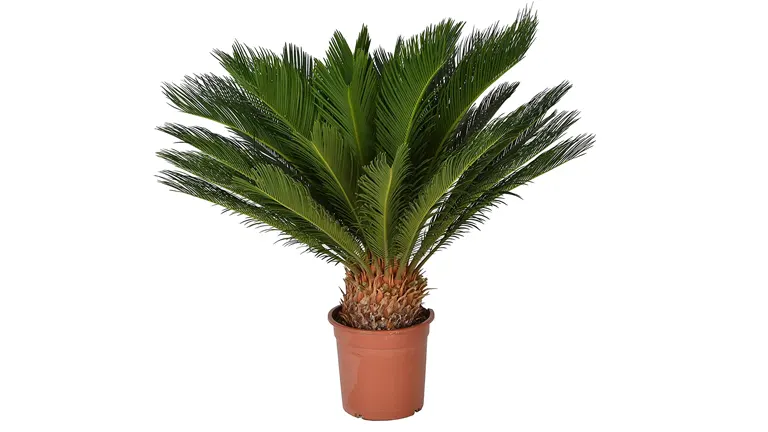
The Sago Palm is esteemed in indoor plant collections for its distinctive, ancient aesthetic and hardiness. Notably different in appearance with its thick, shaggy trunk and stiff, glossy fronds, it adds a prehistoric or exotic touch to any interior. Its slow growth rate is particularly advantageous for indoor environments, as it requires minimal repotting and maintenance over the years. The Sago Palm is also adaptable to a range of light conditions, though it prefers bright, indirect light. It’s drought-tolerant, needing less frequent watering compared to many other palms, which is beneficial for those seeking low-maintenance indoor plants. While it requires caution due to its toxicity if ingested, its unique appearance and resilience make it a popular and striking choice for indoor gardening enthusiasts.
- Water Requirements: Prefers moderate watering. Allow the soil to dry out between waterings to avoid root rot. Overwatering is a common issue with Sago Palms, so it’s crucial to ensure good drainage.
- Light Requirements: Thrives in bright, indirect light but can also tolerate some direct sunlight. However, too much direct sun can scorch the leaves, so a balance is important.
- Color Varieties: The fronds are a deep, glossy green. The stiff, arching leaves give the plant a robust and prehistoric appearance.
Additional Features:
- Distinctive Appearance: The Sago Palm has a rugged, prehistoric appearance with a thick, shaggy trunk and stiff, glossy fronds, making it visually distinct from other indoor palms.
- Slow Trunk Development: Unlike many palms, the Sago Palm develops a trunk very slowly, often taking years to form, which adds to its unique character and appearance.
- Sunlight Adaptability: While it prefers bright, indirect light, the Sago Palm can adapt to a range of light conditions, including some direct sunlight, provided it is acclimated gradually to prevent leaf burn.
- Drought Tolerance: It is more drought-tolerant compared to many other palm species, making it a good choice for less humid environments or for those who prefer plants with less frequent watering needs.
- Cycad Classification: The Sago Palm is actually a cycad, one of the oldest plant families that predates dinosaurs, which is why it has such a distinctive, ancient look compared to true palms.
- Seed Production: Mature Sago Palms can produce seeds in a large, cone-like structure, which is quite rare and interesting when it occurs, especially in indoor settings.
- Scale Leaf Base: The base of the Sago Palm’s fronds is covered in scale-like textures, adding an interesting visual element to the plant’s overall appearance.
8. Majesty Palm (Ravenea rivularis)
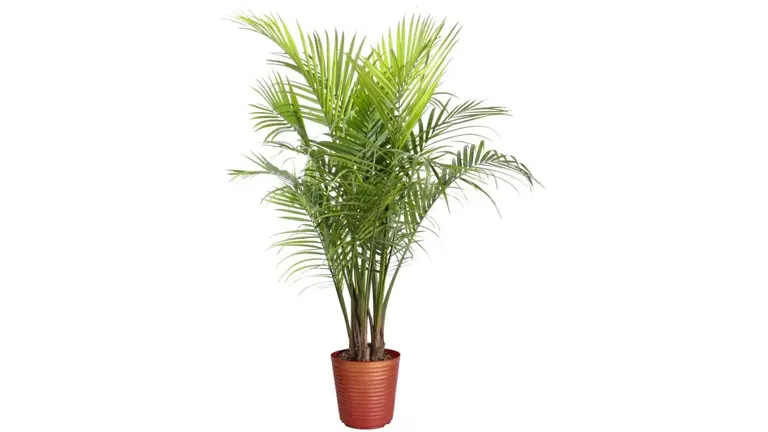
The Majesty Palm is favored for indoor environments due to its striking and elegant appearance, characterized by tall and majestic fronds. This palm’s ability to grow quite large makes it a dramatic centerpiece, especially suitable for spacious rooms where it can add a lush, tropical feel. It thrives in bright, indirect light, aligning well with the lighting conditions found in many homes. Additionally, the Majesty Palm’s need for consistent moisture and higher humidity levels can be easily met with regular misting, making it a manageable choice for those looking to add a dramatic tropical element to their indoor space. Its rapid growth compared to other palms offers a rewarding experience for indoor gardeners looking to see substantial growth and change over time.
- Water Requirements: Regular watering is crucial for the Majesty Palm, with soil needing to remain moist but not soggy. It’s sensitive to both over and under-watering, so maintaining a balance is key.
- Light Requirements: Prefers bright, indirect light. It can tolerate some direct sunlight, but too much can cause leaf burn. Inadequate light can lead to leggy growth.
- Color Varieties: Exhibits bright green, arching fronds that can add a lush, tropical feel to any room. The leaf tips may turn brown if the plant is not receiving adequate water or humidity.
Additional Features:
- Graceful Fronds: The fronds are long, arching, and feathery, creating an elegant canopy that can reach impressive sizes indoors.
- Growth Pattern: It has a relatively fast growth rate among palms, adding a significant presence to indoor spaces in a short amount of time.
- Temperature Preference: Prefers warm temperatures, ideally between 65-75°F, and is sensitive to cold drafts or temperatures below 55°F.
- Humidity Needs: High humidity is essential for its health. Regular misting, a pebble tray, or a humidifier can help meet its humidity requirements.
- Soil Type: Requires a well-draining soil rich in organic matter. A potting mix designed for palms or a mix including peat moss and sand is ideal.
- Fertilization: Benefits from regular feeding during the growing season with a palm-specific or general houseplant fertilizer.
- Potting and Repotting: Prefers to be slightly root-bound. Repotting every 2-3 years or when the roots significantly outgrow the pot is recommended.
9. European Fan Palm (Chamaerops humilis)

The European Fan Palm is highly valued as an indoor plant for its unique fan-shaped leaves and robust nature. Its distinct leaf shape adds an architectural element to indoor spaces, making it a striking addition to home or office décor. This palm’s adaptability to a range of light conditions, from full to partial sunlight, makes it versatile for various indoor environments. Notably, it is more cold-tolerant than many other palms, offering flexibility in placement and increasing its suitability for cooler indoor climates. Additionally, its slow growth rate and compact size mean it won’t outgrow indoor spaces quickly, making it a practical choice for those with limited space. The European Fan Palm’s hardiness and low maintenance requirements make it an excellent option for both novice and experienced plant enthusiasts looking to add a touch of Mediterranean flair to their indoors.
- Water Requirements: Requires moderate watering. It’s important to let the soil dry out between waterings, as overwatering can lead to root rot. This palm is more drought-tolerant than many other species.
- Light Requirements: Thrives in full to partial sunlight. It can tolerate more sunlight than most indoor palms, but should be acclimatized gradually to prevent leaf burn.
- Color Varieties: Exhibits blue-green to silvery green fan-shaped leaves, offering a unique color palette that can add a striking contrast to typical green indoor plants.
Additional Features:
- Leaf Shape: The distinct fan-shaped leaves set it apart visually from other palms, adding architectural interest to indoor spaces.
- Cold Tolerance: More tolerant of cold temperatures than most palms, making it suitable for cooler indoor environments or temperate outdoor settings.
- Growth Pattern: Typically grows as a multi-trunk palm, which can create a fuller, bushier appearance compared to single-trunk species.
- Size and Growth Rate: It grows slowly and remains relatively compact, making it ideal for smaller spaces or as a tabletop palm.
- Soil Preferences: Prefers well-draining soil. A mix of regular potting soil with added sand or perlite can improve drainage.
- Fertilization: Benefits from light fertilization during the growing season. Use a palm-specific or balanced fertilizer.
- Pruning Needs: Minimal pruning is required. Trimming off old or damaged fronds can help maintain its shape and health.
10. Cat Palm (Chamaedorea cataractarum)
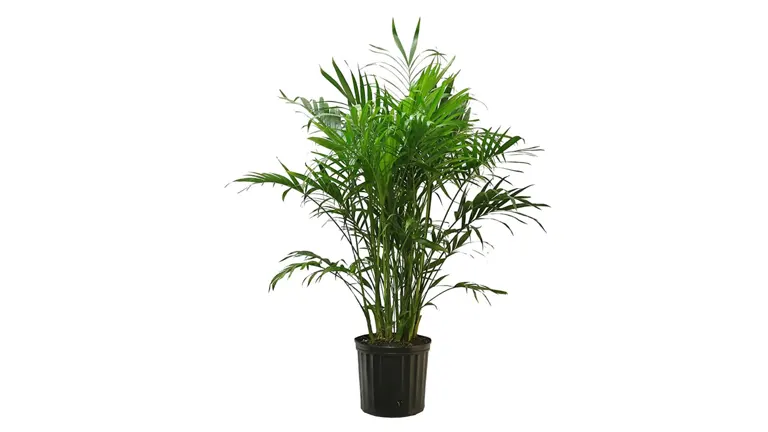
The Cat Palm is particularly celebrated for indoor use due to its lush, dense foliage and ability to thrive in typical home conditions. Its preference for bright, indirect light and higher humidity mirrors the environment of many indoor settings, making it a natural fit for homes and offices. Notably, the Cat Palm’s smaller stature allows it to be conveniently placed on shelves or tabletops, bringing a vibrant, tropical touch to smaller spaces. This palm’s dense leaf canopy is effective at adding a lush greenery feel to any room, enhancing both the aesthetic and the air quality. It’s also known for being relatively easy to care for, requiring consistent moisture and benefiting from regular misting, which can be easily managed even by less experienced plant owners. The non-toxic nature of the Cat Palm makes it a safe option for households with pets and children, adding to its appeal as a household plant.
- Water Requirements: Prefers evenly moist soil; it’s important to water regularly without allowing the soil to become waterlogged. Good drainage is essential to prevent root rot.
- Light Requirements: Best in bright, indirect light. It can tolerate lower light levels, but its growth may slow. Direct sunlight should be avoided as it can burn the leaves.
- Color Varieties: Has lush, dark green fronds that can add a dense, tropical feel to any indoor space. The leaves have a feathery appearance, providing a soft texture.
Additional Features:
- Compact Growth: Ideal for smaller spaces, its compact size makes it perfect for tabletops, shelves, or as an understory plant in larger indoor gardens.
- Leaf Arrangement: Features a dense cluster of slender, arching leaves, creating a bushy appearance.
- Humidity Preference: High humidity levels are preferred, making it well-suited for bathrooms or kitchens, or areas with a humidifier.
- Air Purification: Effective at filtering indoor air pollutants, contributing to a healthier indoor environment.
- Soil Type: A peat-based potting mix with good aeration and drainage works best.
- Fertilization: Responds well to regular feeding with a diluted houseplant fertilizer during the growing season.
- Pruning and Maintenance: Regularly remove any yellowing or dead fronds to maintain its appearance and health.
Factors to Consider When Choosing a Palm Plants to Grow Indoors
- Light Requirements: Different palm species require varying levels of light. Some, like the Parlor Palm, can thrive in low light, while others, such as the Majesty Palm, need bright, indirect sunlight. Assess the light availability in your intended area for the palm and choose a species that aligns with those conditions.
- Watering Needs: Palms generally prefer well-draining soil and varied watering schedules. For instance, the Areca Palm needs consistent moisture, whereas the Sago Palm prefers drier conditions. Over or under-watering can lead to health issues for the plant, so understanding each palm’s specific water requirements is crucial.
- Growth Habit and Size: The ultimate size and growth pattern of the palm should align with your space availability. Smaller palms like the Pygmy Date Palm are ideal for tabletops, whereas larger varieties like the Kentia Palm are better suited for open spaces in living rooms or hallways.
- Humidity and Temperature Tolerance: Most palms prefer a humid environment and warm temperatures, mimicking their native tropical habitats. However, some palms, like the European Fan Palm, are more tolerant of temperature fluctuations and less humid conditions, making them more adaptable to average home environments.
- Maintenance and Care Level: The care level varies among palm species. Some palms require regular pruning and specific feeding routines, while others are low maintenance. The Lady Palm, for instance, is known for its pest resistance and ease of care, ideal for those who want a hassle-free plant.
- Air Purifying Qualities: Many indoor palms, such as the Bamboo Palm, are known for their air-purifying abilities, removing toxins from the air. If improving indoor air quality is a priority, choose a palm known for this trait.
- Pet and Child Safety: Some palms, like the Sago Palm, are toxic if ingested. If you have pets or young children, it’s crucial to opt for non-toxic varieties like the Areca Palm or Parlor Palm.
- Aesthetic and Design Considerations: The visual appeal of the palm should complement your interior décor. Palms offer a range of looks, from the elegant fronds of the Kentia Palm to the architectural leaves of the European Fan Palm, catering to different aesthetic preferences.
Indoor Palm Plant Care Tips
- Proper Lighting: Palms generally prefer bright, indirect sunlight. For example, the Areca Palm thrives under indirect light but can tolerate some shade. Place palms near a window where they can receive filtered sunlight; direct exposure can scorch their leaves. For darker spaces, choose a palm like the Parlor Palm, which is more tolerant of low light conditions.
- Consistent Watering: Watering needs vary among palm species, but most require consistent moisture. Over-watering can lead to root rot, so ensure the pot has drainage holes. For example, the Cat Palm prefers consistently moist soil, whereas the Sago Palm requires less frequent watering. Always check the top inch of the soil for dryness before watering.
- Maintaining Humidity: Palms often thrive in higher humidity, reminiscent of their tropical origin. Indoor environments can be dry, especially in winter, so consider using a humidifier or misting the leaves regularly. The Majesty Palm, for instance, benefits greatly from higher humidity levels.
- Fertilizing Regularly: During the growing season (spring and summer), feed your palm with a balanced liquid fertilizer monthly. Reduce feeding in the fall and winter when growth slows. The Bamboo Palm, for example, responds well to regular but light fertilization.
- Pruning and Cleaning: Remove dead or yellowing fronds to keep your palm healthy and attractive. Also, dust the leaves occasionally to unblock the pores, ensuring efficient photosynthesis. This is particularly important for palms with denser foliage, like the Cat Palm.
- Temperature Control: Most indoor palms prefer warm temperatures (65-75°F) and should be protected from cold drafts and sudden temperature changes. The European Fan Palm is more tolerant of cooler temperatures and can be a good option for cooler indoor areas.
- Repotting When Necessary: Palms generally prefer to be pot-bound and do not need frequent repotting. Repot only when the roots have filled the pot, typically every 2-3 years. Use a well-draining potting mix suitable for palms.
- Pest Management: Keep an eye out for common pests like spider mites, mealybugs, and scale insects. Regularly inspecting the leaves and using organic pest control methods can help keep your palms pest-free. This is especially crucial for palms like the Areca Palm, which can be prone to spider mites.
Conclusion
In summing up, the diverse range of palm plants we’ve explored demonstrates their incredible versatility and adaptability for indoor environments. Each variety, from the air-purifying Areca Palm to the elegant Kentia and the compact Parlor Palm, offers unique benefits and aesthetic appeal. These palms not only enhance interior decor but also contribute positively to indoor air quality and overall well-being. No matter your space or lifestyle, there’s a palm plant that can seamlessly integrate into your home, bringing a touch of the tropics and a sense of nature’s tranquility indoors.
FAQs
- How do I deal with brown tips on my indoor palm leaves?
Brown tips can be a sign of low humidity or over-fertilization. Increase humidity around the plant and ensure you’re not overfeeding. Trimming the brown tips can also improve the appearance. - Can I propagate my indoor palm plant from cuttings?
Most palm plants do not propagate easily from cuttings. They are usually propagated through seeds or by dividing the root ball in species that clump as they grow. - Why is my indoor palm not growing new fronds?
This could be due to insufficient light, incorrect watering, or a need for fertilization. Ensure your palm is receiving adequate light and care according to its specific needs. - How do I protect my indoor palms from common pests?
Regularly clean the leaves and inspect for pests. Neem oil or insecticidal soap can be effective treatments. Ensuring good air circulation around the plant also helps prevent pest infestations. - What’s the best way to increase the pot size for an indoor palm?
Repot your palm into a slightly larger pot (2-3 inches wider) with fresh soil. Do this preferably in the spring to give the plant time to acclimate and grow. - Are there any dwarf palm varieties suitable for small apartments?
The Pygmy Date Palm and the Parlor Palm are both excellent choices for small spaces due to their compact sizes. - How can I tell if my indoor palm needs more light?
Signs of insufficient light include slow growth, small new leaves, or a general pale look to the foliage. Consider moving it to a brighter location or using grow lights. - Can indoor palms thrive in artificial light?
Yes, some palms can adapt to artificial light. Species like the Parlor Palm and the Kentia Palm can do well under bright, indirect artificial lighting conditions.
As we’ve explored the diverse world of indoor palm plants, it’s clear that each variety brings its own unique beauty and benefits to our living spaces. Whether you’re a seasoned plant enthusiast or a beginner, incorporating these palms indoors can transform your home into a more vibrant, serene, and nature-infused sanctuary. Happy planting!

Benjamin Brooks
Forestry AuthorGreetings! I'm Benjamin Brooks, and my journey over the past 15 years has revolved around the fascinating realms of content creation, expertise in snow clearing, and the intricate world of lumberjacking and landscaping. What began as a simple curiosity about the natural world and heavy machinery has evolved into a passionate profession where my love for crafting words intertwines seamlessly with my lumberjacking and garden skills.

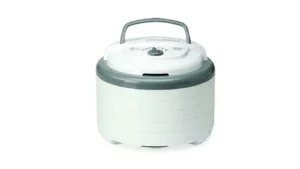








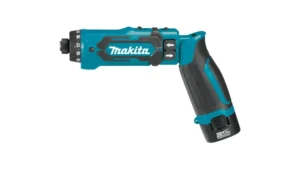
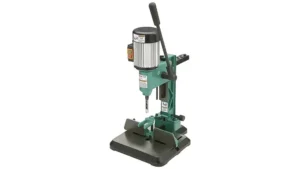

Leave your comment